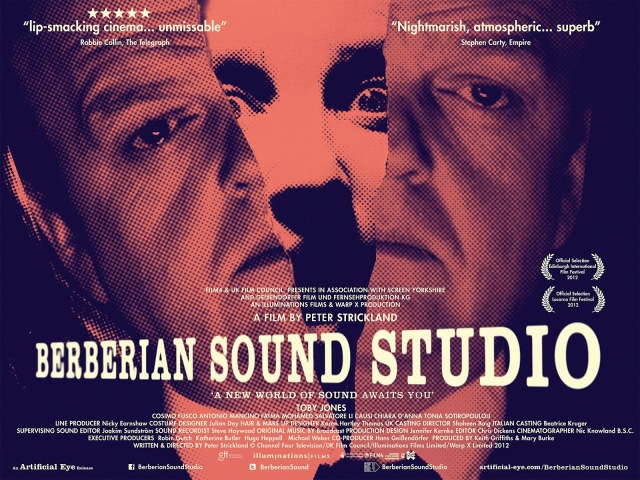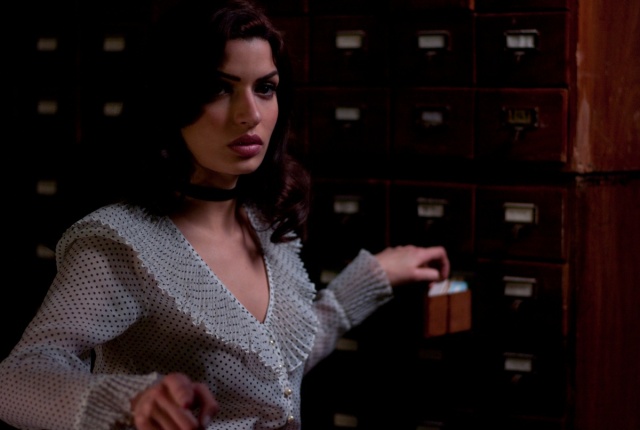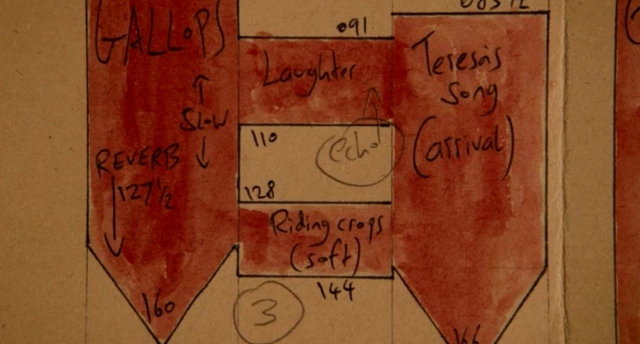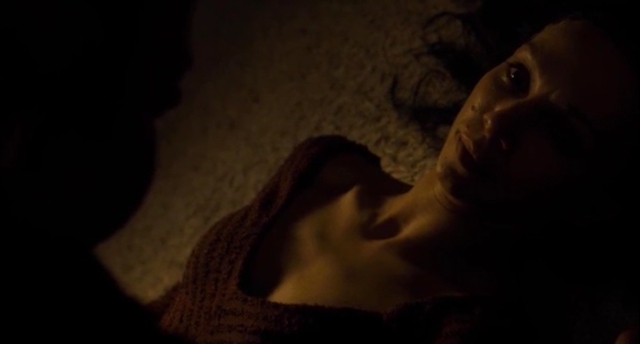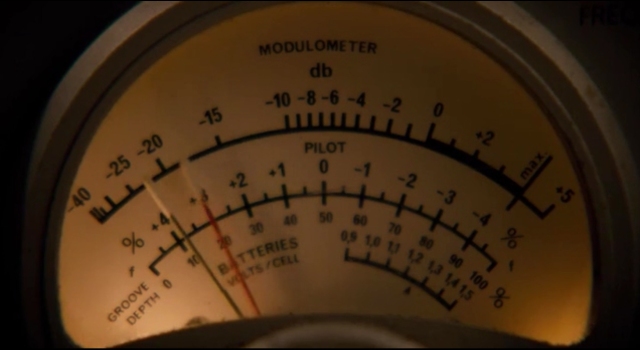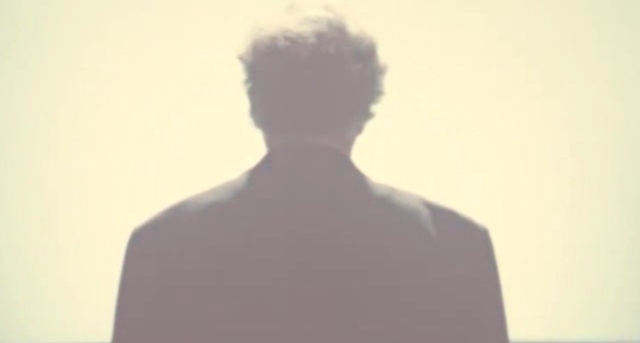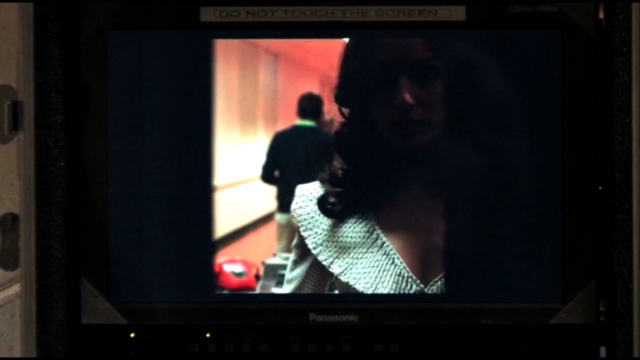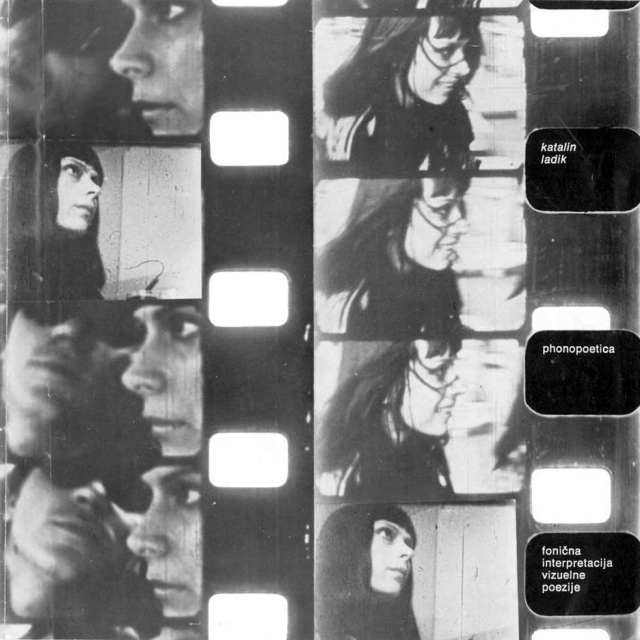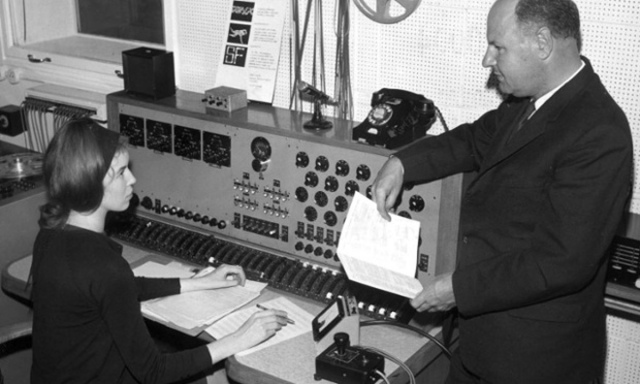BERBERIAN SOUND STUDIO
Toby Jones, Antonio Mancino, Guido Adorni, Susanna Cappellaro, Tonia Sotiropoulou, Chiara D’Anna, Eugenia Caruso, Fatma Mohamed, Lara Parmiani, Hilda Péter, Katalin Ladik, Kata Bartsch, Layla Amir .. / Cinematog. Nicholas D. Knowland / Art Dir. Sarah Finlay / Music Broadcast / Producers Mary Burke & Katherine Butler / Written & Directed by Peter Strickland
When timid Foley & Sound Engineer Gilderoy (Toby Jones) arrives at the Italian ‘Berberian Sound Studio’ to begin work, he brings with him an innate self-effacing, parochial Britishness, which is immediately at odds with the demonstrative, fiery latins who surround him. His world is that of the Radio-Shack, spent in relative, meditative isolation amidst industrial banks of spooling tapes, flickering dials and arcane sound charts. Though expressly invited, and more than qualified for the work at hand, Gilderoy is a quiet, reclusive person, not at all equipped emotionally to deal with impassioned creative types in close quarters.. let alone the psycho-sexual world of Italian Giallo Cinema. The Berberian Sound Studio explores the tradition of dubbing and Foley work in Italian cinema, the creative process of applying voice and sound effects in post-edit.. but on a deeper level we are drawn into the clash between British and Italian sensibilities, as well as that eternal debate on the effects of violence in Cinema.
Although there is a clear tradition of the ‘film within a film’, which goes back to the very beginning of cinema with Chaplin knocking through the fourth-wall of his Keystone set, the concept of the filmmaker himself becoming affected by his own machinations is much more a part of Sixties introspection. In 1966 Michelangelo Antonioni’s ‘Blow-up‘ followed David Hemmings imitation of Photographer David Bailey around Swinging London, whose ‘camera never flinches’, capturing ‘love without meaning.. murder without guilt.. the dazzle and madness of youth today.’ Not so much stealing souls with his camera, as intruding upon their private selves. The notion of capturing people on film becoming an inherently sinister activity, with Vanessa Redgrave’s insistent cry – “What are you doing? Stop it! Stop it! Give me those pictures. You can’t photograph people like that!”
With Michael Powell’s ‘Peeping Tom‘, the filmmaker himself turns killer, impaling female victims on the end of a phallic, spiked tripod, only to revisit his recordings time and time again in the cozy sanctity of home projections.. “Whatever I photograph I always lose.” mournfully muses our killer. Roll forward to the early 80’s, and we arrive at Brian De Palma’s ‘Blow-out‘, essentially a reinterpretation of Antonioni’s ‘Blow-up‘, though this time around focusing on Sound rather than image.. here we have John Travolta accidentally capturing a highway accident on sound-tape, only to discover that it is actually an assassination. De Palma takes us into the world of Foley effects, with particular attention to the tenuous line between art and an actual snuff-film, as Travolta seeks the perfect female victim scream for his Horror Movie assignment.
“That’s a terrible scream. Jack, what cat did you
have to strangle to get that?” (Blow-out (1981)
To this creative cine-spring, Director Peter Strickland pours in a generous helping of Italian Giallo, with his cast of Argento style female victims, and laces the whole piece with the arcane world of Sprechstimme, an esoteric vocal explosion of speech, singing, growling, screaming, shouting, whispering, panting and hissing. Foremost in this tradition, and inspiration behind the film’s title, is Cathy Berberian (1925-1883), an American mezzo-soprano who released a series of bizarre experimental albums (‘Visage’ in 1961 and then in 1965 ‘Sequenza III, per voce femminile’) in collaboration with her then husband composer Luciano Berio. Strickland cast a fascinating collection of vocal talents, including the 70’s year old Hungarian poet & performance artist Katalin Ladik, and the intriguingly emotive voice artist Lara Parmiani.
This feminised world of sound reminds us of the haunting one-man-band (or one-woman band rather) Delia Derbyshire, creator of many of the strange sound effects and themes for the 60’s Doctor Who serial.. willowy, elegant, and other-worldly.. exploring dreamstates and rippling sonics tucked away in her BBC cupboard. In some senses woven into the character of Gilderoy himself. Of course, we have to add both Dario Argento and of the Italian electric band Goblin to proceedings, since it is Argento’s cult film Suspiria that is being heavily referenced throughout. Argento films more than any of his contemporaries utilised American and English stars alongside his Italian cast, to contrast and to compliment in comparison. From David Hemmings in Profondo Rosso (Deep Red), to Jessica Harper in Suspiria, and Jennifer Connelly in Phenomena.. each with that rather curious double release, one with the whole cast dubbed into Italian (the Italian speakers re-dubbing themselves), and then the same in reverse. Though this may seem strange to those uninitiated into the world of Argento’s horror work, it is nonetheless immediately familiar to most, recalling any of Sergio Leone’s Spaghetti Westerns.
It’s ever been a supreme irony that exploitation cinema has tended to employ more actresses per quota than in the mainstream, whilst at the same time being shamelessly guilty of blatant sexism.. and yet, somehow Peter Strickland with Berberian Sound Studio, and his second feature ‘The Duke of Burgundy‘, has managed to explore the genre, yet elegantly critique at the same time.. Fatma Mohamed, the central female lead manages to turn the tables on Berberian’s male aggressors, and exit the fray before any retaliation for her sabotage. What we have is a melting pot of Latin femininity, filtered through a British perspective. Even the production itself depicts a fictional Italian Sound Studio on film, though in reality was filmed at The Three Mills Studio in Bow, East London. This fascination with duality that Strickland toys with, no doubt originates from his own dual heritage of both Greek & British. To twist us into a further eddy of confused location, Gilderoy is queasily sucked into the very fabric of the melting celluloid, taking us with him as the bubbling and melting filmstrip resolves itself into a 1970’s documentary about the rolling countryside of Box Hill, in England’s Surrey. This too is a double illusion, since the incredibly believable short film is in fact another Strickland forgery, with a flavour of Robin Hardy’s seminal 70’s Horror piece ‘The Wicker Man‘, peppered with Pagan symbolism.
Ultimately all sense of reality vapourises, as Gilderoy loses his own voice entirely, Italian force-fed through his lips, quite literally dubbed out of character, his Englishness overridden.. helpless to the dictates of the Director. If it seems familiar, this loss of control to the author.. a voice in the back of your head may be whispering Dennis Potter..
“You just don’t know writers. They’ll use anything, anybody. They’ll eat their own young.”
(‘The Singing Detective’ by Dennis Potter)
———————————————————————————
———————————————————————————
CINE-INFLUENCES
x
x
x
x
———————————————————————————
CAST PHOTOGRAPHY
x
———————————————————————————
CATHY BERBERIAN
———————————————————————————
BROADCAST – Earlier work: Ha Ha Sound (2003)
———————————————————————————
In Collaboration with Peter Strickland:
THE SONIC CATERING BAND – A Gourmet’s Slumber (2012)
—-
KATALIN LADIK – Phonopoetica (1976)
—-
Delia Derbyshire (1937-2001)
x

